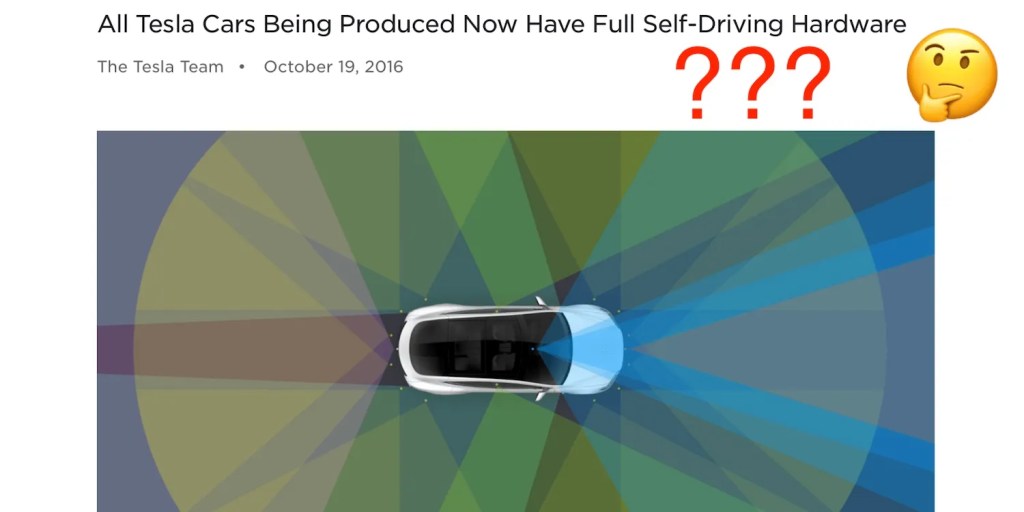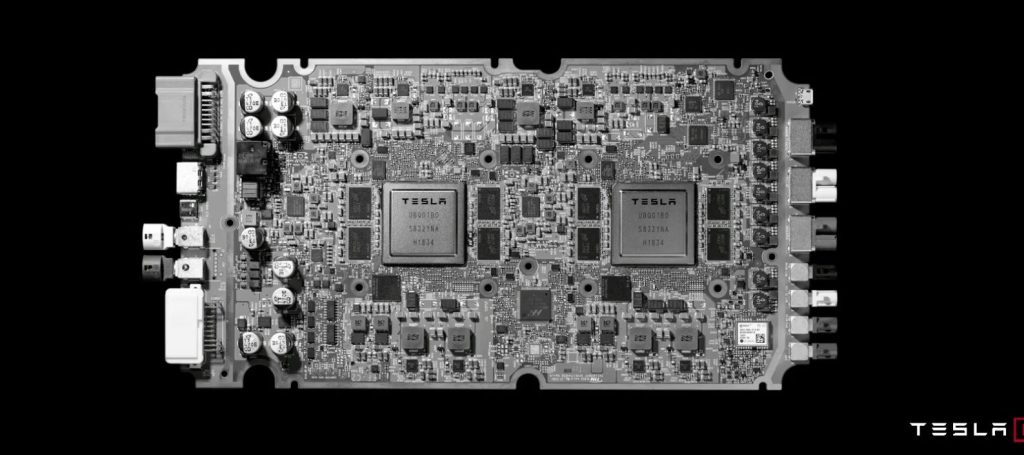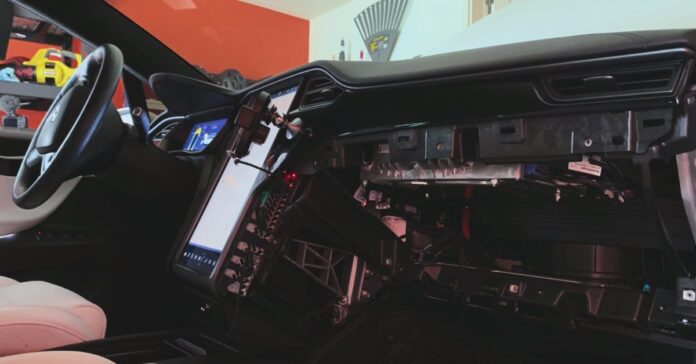Tesla (TSLA) has to replace the ‘self-driving’ computer inside about 4 million vehicles or likely compensate the owners of those vehicles.
The liability could be more significant than the largest automotive recall in terms of cost.
In 2016, Tesla claimed that all its vehicles in production going forward have “all the hardware necessary for full self-driving capability.”
Tesla’s use of the term “full self-driving” has changed over the years, but at the time and for years later, CEO Elon Musk claimed that it would mean Tesla owners would eventually receive a software update that would turn their vehicles into “robotaxis” capable of level-4-5 self-driving, which means unsupervised autonomous driving even with no one in the cars.
Almost 10 years later, this has yet to happen and won’t happen soon in most of the cars Tesla has delivered over the last decade.

Tesla’s claim that its vehicles have “all the hardware necessary for full self-driving capability” quickly proved untrue.
At the time, Tesla was producing its vehicles with cameras, a front-facing radar, ultrasonic sensors, and a “self-driving” computer, called HW2.5.”
Tesla quickly started building new vehicles with a new “HW3 self-driving computer” and admitted that its HW2.5 computer was not powerful enough to achieve self-driving capability.
The automaker started retrofitting existing HW2.5 vehicles for free with new HW3 computers owned by drivers who bought Tesla’s ‘Full Self-Driving’ (FSD) software package.
In 2023-2024, Tesla transitioned to another new and more powerful “self-driving computer”, HW4, in its new vehicles.
Unlike when it transitioned from HW2.5 to HW3, this time, Tesla claimed it would still be able to deliver its robotaxi self-driving capability to HW3 vehicles.

Musk even claimed that FSD will get better on HW3 first, as Tesla’s “focus needs to be on getting FSD on HW3 working super well and provided internationally”. He went as far as claiming that FSD performance on “HW4 will lag at least 6 months behind HW3” because of this.
That didn’t last long.
In 2024, we started to report that Tesla was reaching the limits of the HW3 computer, while the capabilities were nowhere near the promised unsupervised robotaxi-level autonomous driving.
It took another 6 months, but in January 2025, Musk finally admitted that HW3 computers are not powerful enough to achieve unsupervised self-driving capability.
There are about 4 million Tesla vehicles in the world with HW3 computers:
| Hardware Version | Production Timeframe | Estimated Vehicles Produced (Global) | Rollout & Overlap |
|---|---|---|---|
| HW3 (FSD Computer) | Apr 2019 – Late 2023 (phased out) | ~4 million (approx.) | Standard in all models from 2019–2022; remained in some cars through 2023. Overlap with HW4 during 2023. |
| HW4 (FSD Computer) | Jan 2023 – Present (ongoing) | ~2.5–3 million (approx.) | Introduced Jan 2023 (S/X first); became standard across all models by early 2024. Overlapped with HW3 in 2023. |
When admitting the computer won’t support the promised self-driving capabilities, Musk said that Tesla would retrofit the computers of all HW3 car owners who purchased the FSD package:
I mean, I think the honest answer is that we’re going to have to upgrade people’s Hardware 3 computer for those that have bought full self-driving, and that is the honest answer and that’s going to be painful and difficult but we’ll get it done. Now I’m kind of glad that not that many people bought the FSD package.
Musk says that replacing all the computers will be “painful,” and he is “glad” that “not that many people bought the FSD package.”
Tesla never disclosed the official take rate of its Full Self-Driving (FSD) package, but it did disclose having 400,000 FSD beta testers in North America by the end of 2022.
The take-rate is believed to be much lower globally due to the limited value in other markets where Tesla offers fewer ADAS features under the FSD package.
Globally, it’s safe to assume at least another 100,000 HW3 vehicles with the FSD package, which should bring Tesla’s retrofit requirement to over half a million units.
Musk is right to say that replacing the computers in over 500,000 Tesla vehicles will be “painful.” It will strain its service capacity tremendously, on top of the cost, which will easily surpass $500 million.
But that might just be the beginning.
Tesla promised self-driving hardware in all cars
Musk and Tesla not only made promises to those who bought the FSD package, but they promised anyone buying Tesla vehicles since 2016 had “all the hardware necessary for full self-driving capability.”
As we previously reported, Tesla removed the claim from its website last year and changed the language around the FSD package, which was likely aimed at weakening claims for Tesla HW4 owners, but the case for HW3 owners is more straightforward.
In 2019, Musk claimed “Tesla vehicles are now appreciating assets” because of their future self-driving capabilities. Of course, this proved to be completely wrong.
But there’s one thing that’s true about the value of Tesla vehicles: they would be worth more if they had computers capable of supporting self-driving, which Musk just admitted is not the case. That’s regardless of whether they bought the FSD package or not.
Therefore, there’s a strong argument to be made that Tesla needs to replace computers in all HW3 cars or at the very least, compensate the owners for falsely claiming that the vehicles had “all the hardware necessary for self-driving.”
In fact, there’s already legal precedent for this.
In 2022, a judge ordered Tesla to upgrade a customer’s self-driving computer for free so that they can subscribe to Tesla’s Full Self-Driving program without any additional cost. It created a precedent for Tesla owners who don’t purchase the FSD package.
Based on Tesla’s statement that “all cars produced since 2016 have the hardware necessary for full self-driving capability,” the owners of those vehicles need to have all the hardware necessary to have access to these features.
It’s a clear case of false advertising. Tesla says, “Your car has all the hardware necessary for full self-driving,” and when an owner wants to try the features, Tesla tells them, “You have to pay $1,000 for us to upgrade your hardware.” Something doesn’t add up.

Electrek’s Take
I would be surprised if Tesla does as Musk claimed and replaces HW3 computers in any car, let alone over half a million cars, or as it should be, about 4 million vehicles.
It’s too complicated and costly. It would add hundreds of thousands of work hours to Tesla’s already ultra-busy service operations, and it may not even work.
After being wrong about HW2.5 and HW3, the level of confidence in Tesla achieving unsupervised self-driving on HW4 vehicles is not really high, despite HW4 vehicles not only having more powerful computers but also better cameras.
I don’t think it’s realistic to believe that Tesla will enable level 4 or 5 self-driving capabilities in what are, in some cases, almost 10-year-old vehicles through a computer retrofit.
My 2018 Model 3 Performance was originally a HW 2.5 vehicle, and I purchased the FSD package. Tesla upgraded my computer to HW3 in 2019. We are now in 2025, and Musk finally admitted that the computer I bought 6 years ago won’t enable the self-driving capacity I was promised.
My car will never be self-driving, and I don’t believe Tesla will ever offer a free computer upgrade.
I think Tesla will have to compensate every Tesla HW3 owner worldwide. That would mean about 4 million vehicles and a liability of several billion dollars.
At first, instead of the computer retrofit, I think Tesla will use this as an opportunity to encourage people to upgrade, like it did with the “FSD transfer windows.” Maybe it will offer buybacks at a higher rate to compensate owners.
As for those who didn’t buy the FSD package, I don’t think Tesla will offer anything based on Musk’s messaging. It will have to go through the courts.
There are already several lawsuits filed against Tesla over its self-driving claims, and that was before Musk’s admission that HW3 won’t support unsupervised self-driving. I believe that those lawsuits will ramp up this year.


